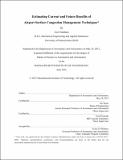Estimating current and future benefits of airport surface congestion management techniques
Author(s)
Nakahara, Alex (Alex Hiroo)
DownloadFull printable version (13.48Mb)
Other Contributors
Massachusetts Institute of Technology. Dept. of Aeronautics and Astronautics.
Advisor
Ian Waitz and Tom Reynolds.
Terms of use
Metadata
Show full item recordAbstract
Air traffic is expected to continue to grow in the future and improved methods for dealing with the increased demand on the system need to be designed and implemented. One method for reducing surface congestion at airports is surface congestion management (SCM) (also commonly called departure queue management or departure metering). The concept generally involves holding aircraft at the gate or in the ramp area instead of releasing them onto the active movement area during periods of high departure demand. The FAA is planning to implement surface congestion management at airports where the cost/benefit analysis is favorable. Therefore, an estimate of the benefits of implementing surface congestion management in the future is necessary. To overcome the uncertainties and difficulties inherent in forecasting, this thesis adopts a multi-fidelity modeling approach and proposes three methods for estimating the benefits of SCM where the higher fidelity models study a subset of airports to inform and validate the lower fidelity models used on the entire set of airports. In the first model, a detailed analysis of a field trial of SCM at JFK airport is conducted using operational data. The second model estimates the benefits of implementing SCM at 8 major US airports from 2010 to 2030 by simulating congestion and performance levels through taxi time estimation. The last model explores several options for generalizing the results to 35 airports in the US. The results are also validated against historical benefits estimates as well as field trials of SCM where available. The findings show that SCM will result in fuel savings on the order of 1% of the total fuel burn in all stages of flight and between 5% and 45% of taxi-out fuel burn, depending on the airport.
Description
Thesis (S.M.)--Massachusetts Institute of Technology, Dept. of Aeronautics and Astronautics, 2012. This electronic version was submitted by the student author. The certified thesis is available in the Institute Archives and Special Collections. Cataloged from student-submitted PDF version of thesis. Includes bibliographical references (p. 103-105).
Date issued
2012Department
Massachusetts Institute of Technology. Department of Aeronautics and AstronauticsPublisher
Massachusetts Institute of Technology
Keywords
Aeronautics and Astronautics.